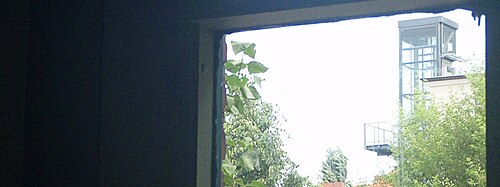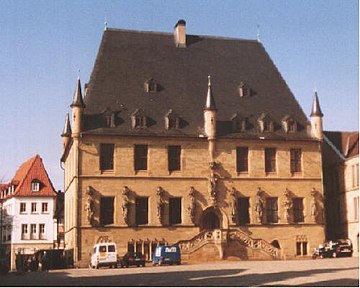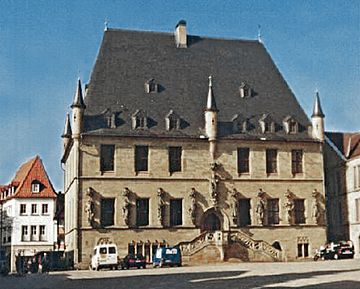Sharpen
When sharpening the change of image information is referred to when this change increased the mutual Discrimination of image details. When sharpening, the actual information content (i.e. the visual sharpness) is not increased, but the acutance . Only the subjective impression of sharpness is increased.
Basics
Color and brightness in photos (digital and film) are always created using color mixing . Different colors are mixed in different brightnesses - the result is a specific color with a specific brightness.
In order to distinguish image details more strongly from one another (to sharpen) these brightness values must be changed. The change can take place globally (affecting the whole picture), locally (between individual picture elements) and structurally (change in point density and color depth ).
contrast

Contrast describes the difference between light and dark parts of an image. Sharpening is the targeted change of this difference.
There are numerous methods for changing the contrast:
- the gradation curve for changing the global density distribution
- the high-pass filter for selecting specific brightness values
- the post-exposure for individual contrast change
- u. v. a.
Contrast change
With all contrast changes, the subjective impression of sharpness of an image can be changed.
Some of the contrast-changing methods (example: brightness regulator) are used for general image optimization - nevertheless they also influence the impression of sharpness.
Other contrast- changing methods (example: unsharp masking ) are used in a targeted manner to increase the impression of sharpness - of course, the impression of brightness of the entire image also changes.
The difference between all counter-modifying procedures is:
- The effective range of the contrast change (pixel-precise, global, edge-emphasizing ...)
- The use of the contrast change (soft transitions, hard edges, subtracting as with unsharp masking ...)
history
The technique of being able to change the subjective impression of sharpness of an image is more than a hundred years old. Using fine brushes and special paint, the image details that are important for the impression of sharpness (mostly eyes and contours) were delicately drawn. This method was so successful that it was used by most professional photographers for such purposes by the late 20th century. Even today, with the appropriate software, images can be retouched in such a way that their impression of sharpness is improved.
The second, also very old method is that of changing the contrast. Using different developer chemistry and paper types as well as targeted re-exposure, the contrast could be manipulated globally in the entire image. In the second half of the 20th century, the change in contrast received a decisive leap in quality: unsharp masking (the contrast is only intensified locally at the edges within an image). Both techniques were able to assert themselves successfully in the digital photo age.
At the beginning of the 1990s a new era in photography was ushered in (very unspectacularly). At this point, 95% of all photos were made in large laboratories. At that time, the large laboratories introduced the technology of automatic image optimization. In a split second, every photo (then analog) was analyzed and manipulated. This technique was able to dodge, re-expose, unsharp masking of each image in tenths of a second. The software on which this process was based required years of fine adjustment (it had to be “trained”). As a result, over time there was a gradual transition to completely different viewing habits. The best way to see this change is by comparing photos from the 1980s and 1990s. Although the technology of the 35mm film (used by most photographers) has not changed significantly during this period, you can clearly see the difference in the photos from this time.
In the years of the millennium, the mass spread of digital photography began. In order to conceal the serious deficiencies of the digital technology at the time, the entire image production line was adapted to the user profiles. A typical example of this is the profile of the “clipper”: Vacation and family motifs should be printed out for the photo album in a size of 10 cm × 15 cm. The printers were set up so that they increased the amount of black much more than was necessary. As a result, the image motifs looked very strong and rich in contrast (impression of sharpness). This concealed the weakness of the printer that it was very difficult to print delicate colors. With the restriction to 10 cm × 15 cm, the physical lack of sharpness of digital images was barely visible.
commitment
Today, sharpening is one of the elementary applications of graphic filters in image processing and is also used automatically in most imaging processes . These "sharpness filters" are precisely matched to the area of action and type of application of the contrast change in an image. Typical filters are
- the emphasis on the edges to easily increase the impression of sharpness
- the unsharp masking for sophisticated image enhancement
Other uses are
- the aperture correction to improve the steepness of low-pass filters in electronic recording systems.


